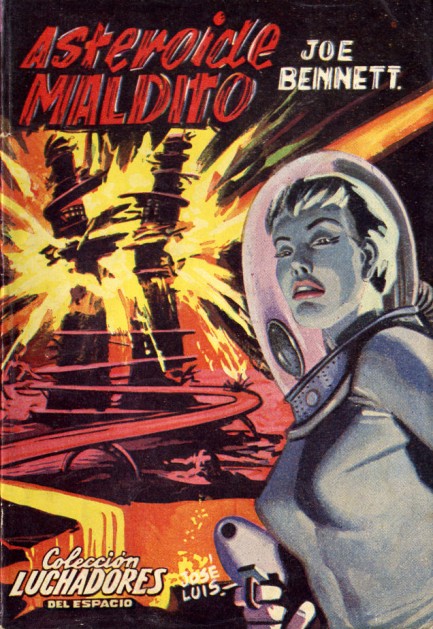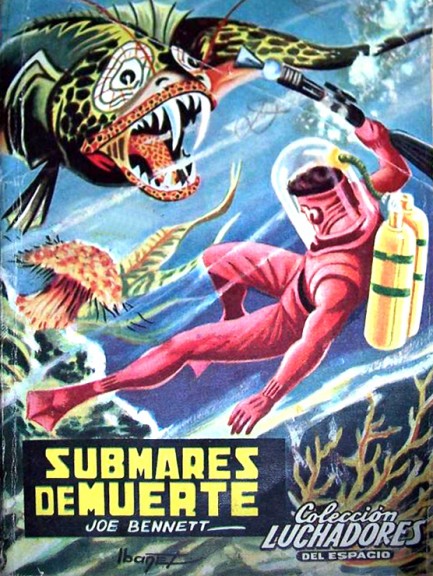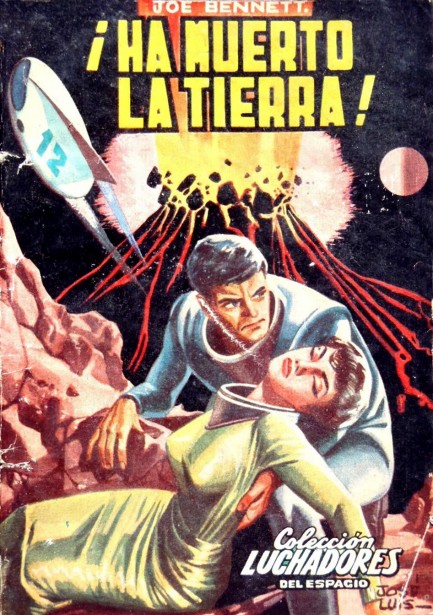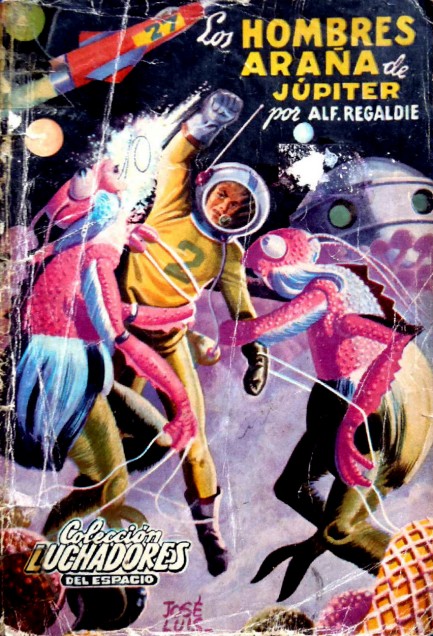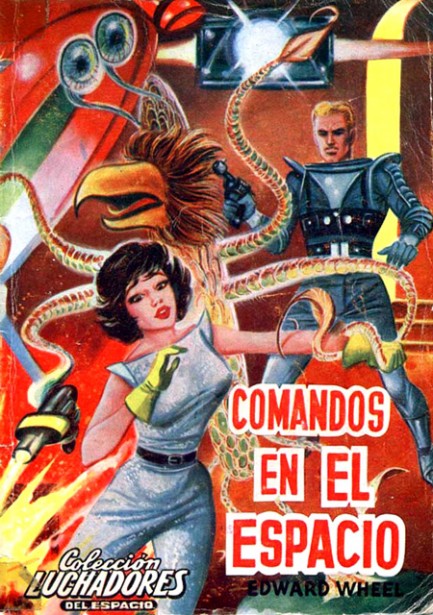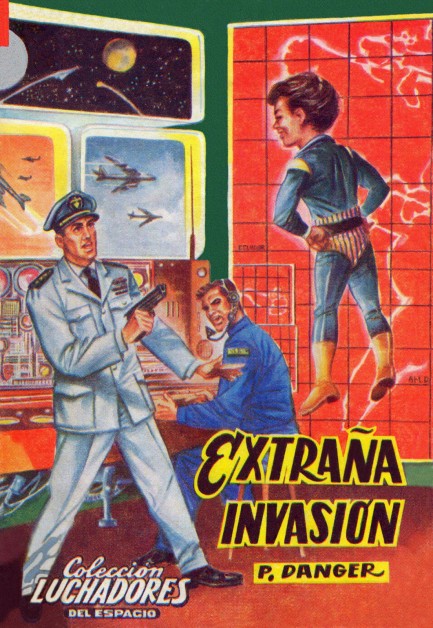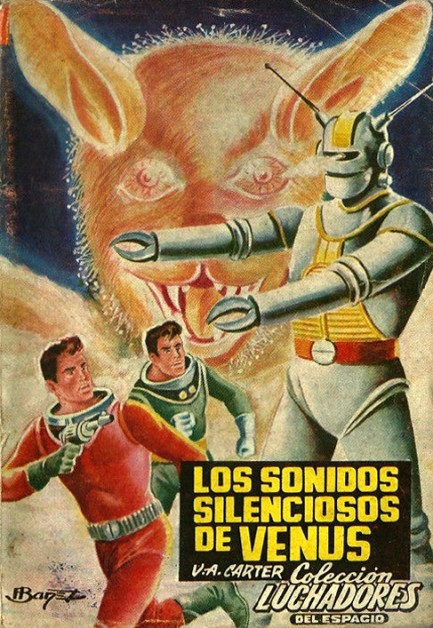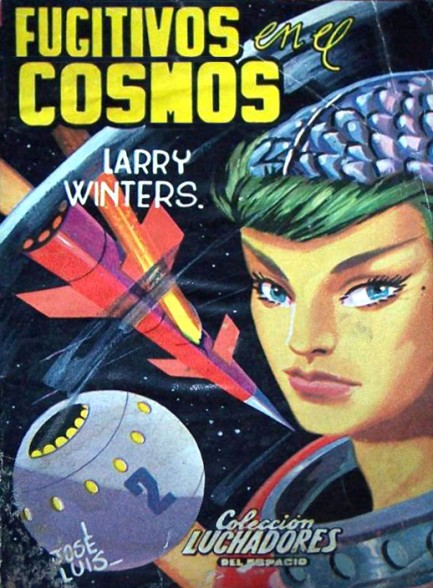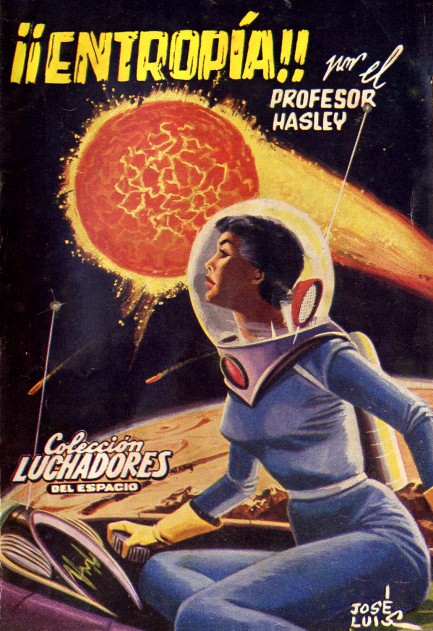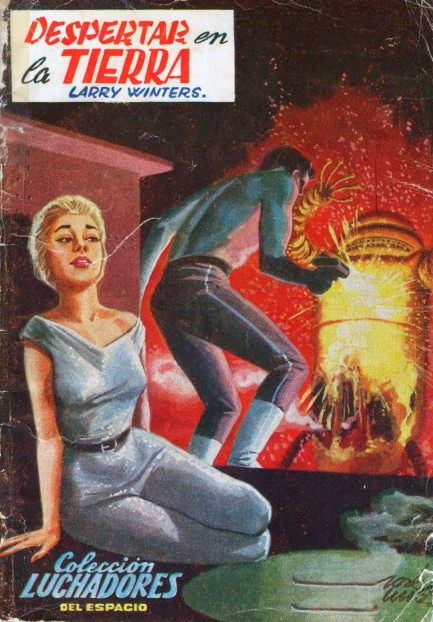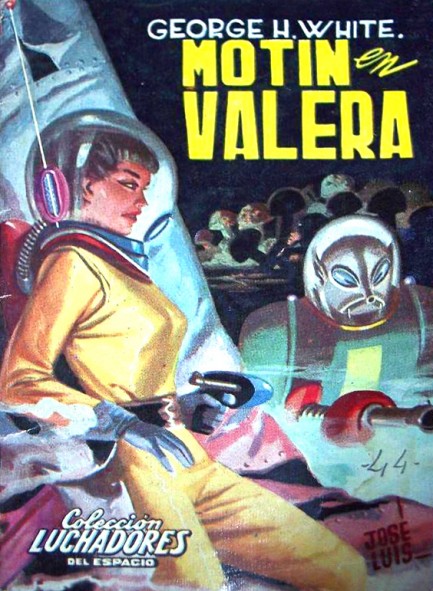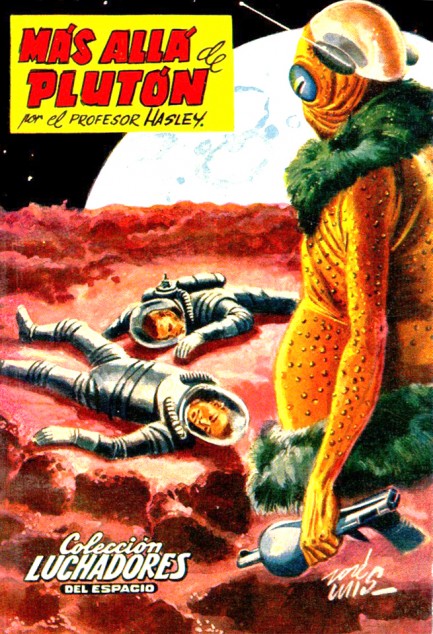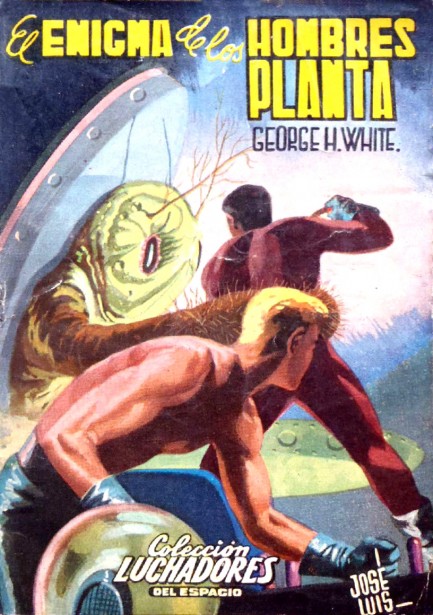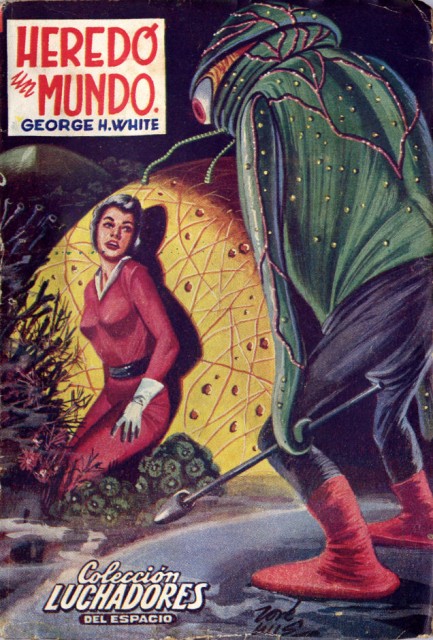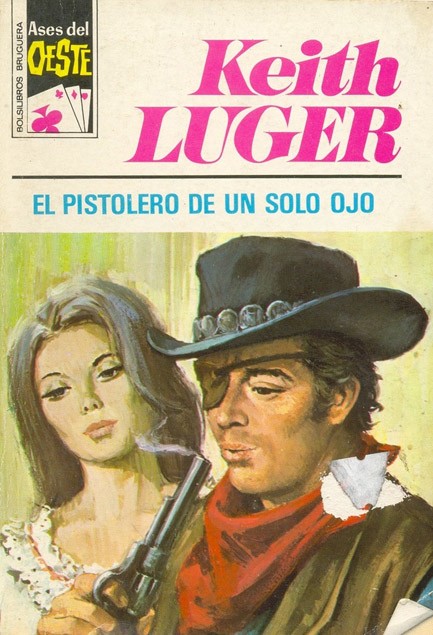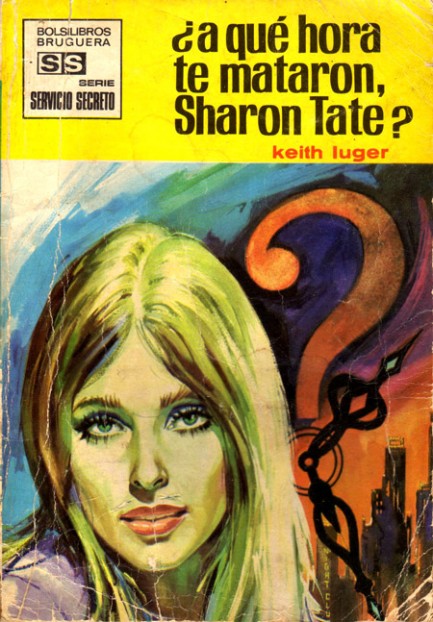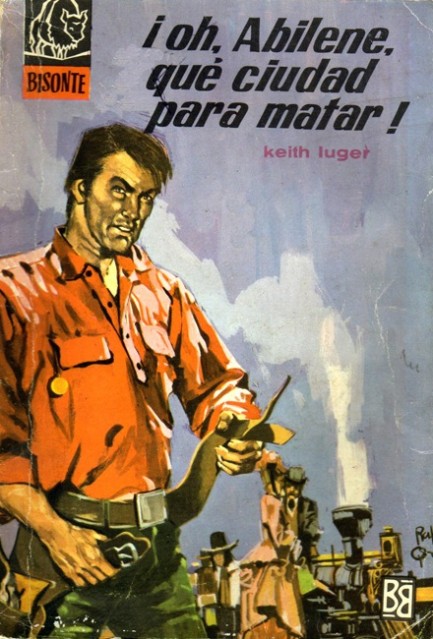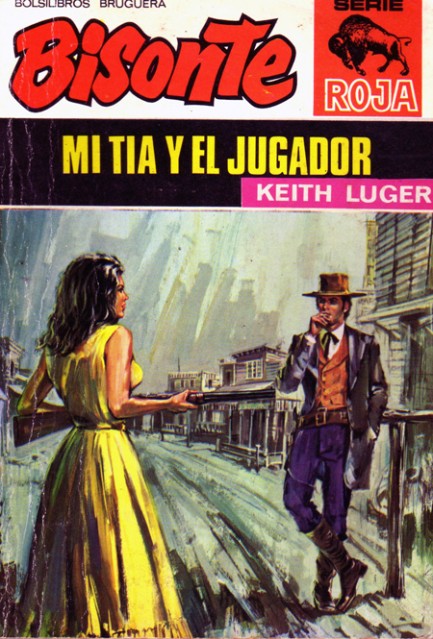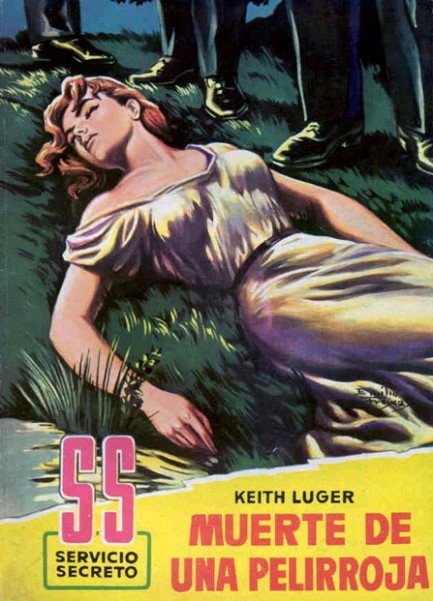 Wherever you look, there it is. 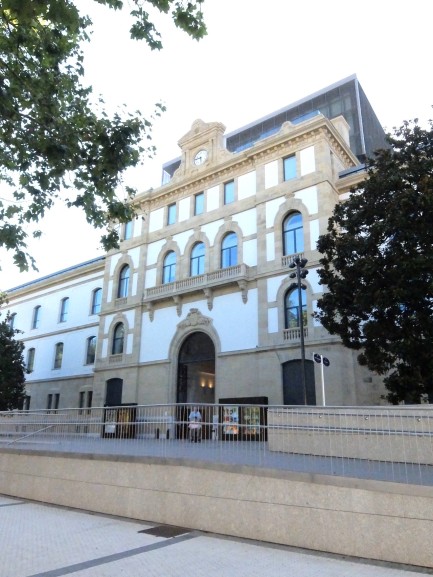 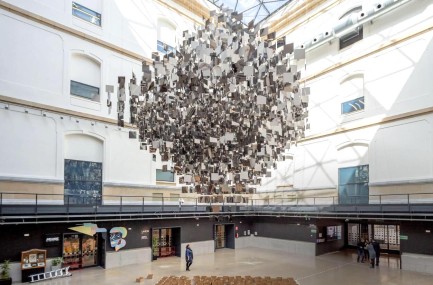
We're back. We said we'd keep an eye out for pulp during our trip to Donostia-San Sebastián, and we did see some, though we couldn't buy it—it was all under glass in a museum. The Tabakalera (above), a cultural space mainly focused on modern art, was staging an exhibit titled, “Evil Eye - The Parallel History of Optics and Ballistics.” A small part of the exhibition was a selection of Editorial Valenciana's Luchadores del Espacio, a series of two-hundred and thirty-four sci-fi novels published from 1953 to 1963. We snuck a few shots of the novels, which you can see below. Overall, though, what was on offer were photos, short films, political literature, and physical artifacts dealing with war and conflict. Since the participants were all artists, journalists, and witnesses from outside the U.S., everything naturally focused on wars that the U.S. started or sponsored—those ones they don't teach in school. The pulp fit because of its suggestion that human conflict would continue even into outer space.
We also said we'd try to pick up some French pulp, and that side trip happened too. We managed to score several 1970s copies of Ciné-Revue that we'll share a bit later, and those will feature some favorite stars. Though the collecting was fun, we're glad to be back. The birthday party was a success, as always, and now we're down south where the weather is gorgeous and hopes are always high. We'll resume our regular postings tomorrow.
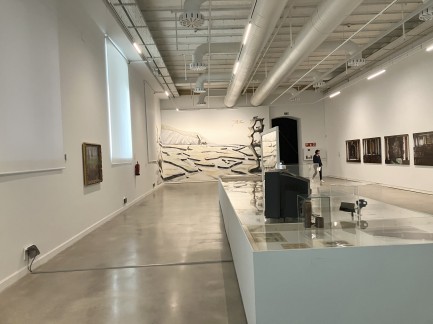 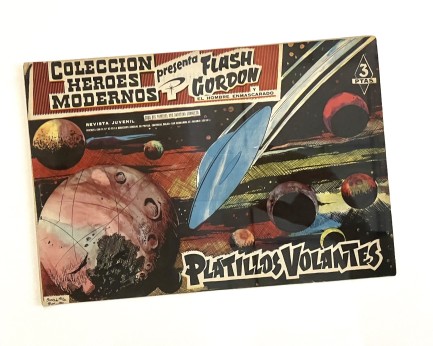 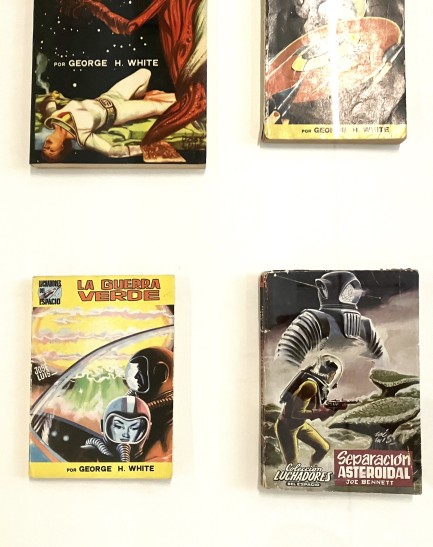 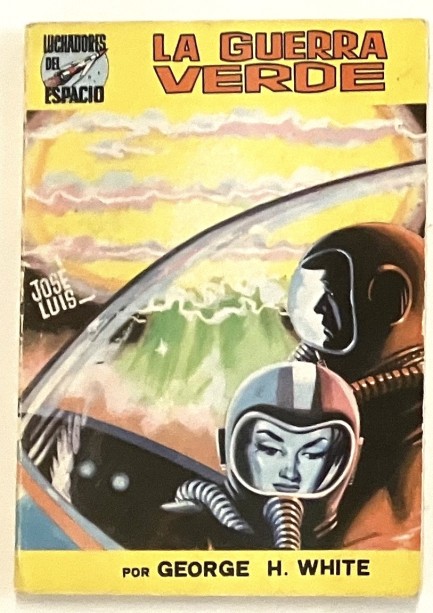
 It's never far below the surface of things. 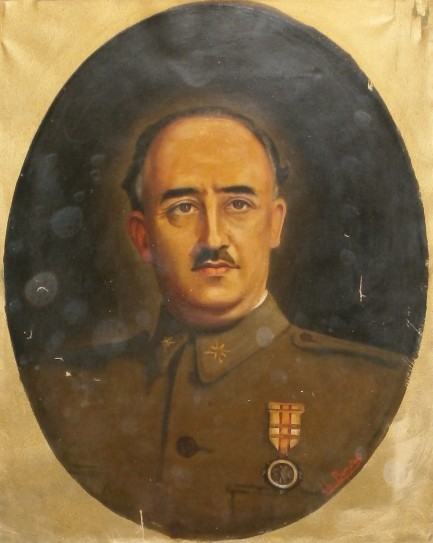
Recently a friend bought a flat, and tucked away under some floorboards was a cache of fascist artifacts. You see one of those above—an oil portrait of Spain's fascist dictator Francisco Franco, clad in his generalissimo uniform, in the full bloom of power. The Spanish Civil War fueled so much literature. Hemingway, Orwell, Sartre, Ramón Sender, and Graham Greene all wrote important works about the war. You notice there's only one Spanish writer in that list? Obviously, due to censorship the best Spanish books came after Franco was gone, which puts them out of our purview, time-wise. But there are numerous Spanish writers who later tackled the subject brilliantly, for example Jesús Torbado.
We think these items we've posted today are excellent examples of real-world pulp. Just below is the yoke and arrows, an old symbol from the 1400s, adopted by the fascist Falange in 1934, and widely utilized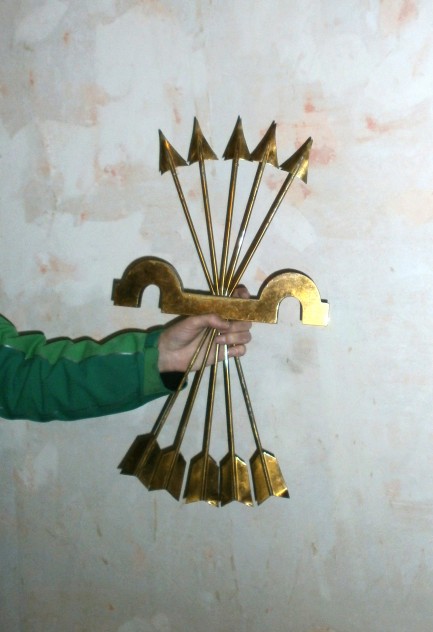 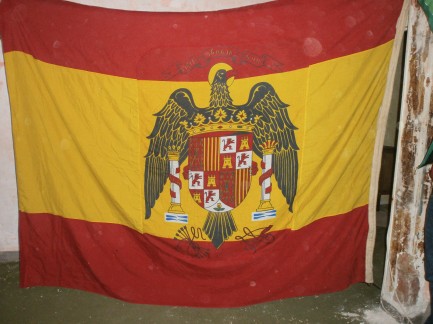 by the nationalist rebels during the Civil War. With the help of Hitler and Mussolini they prevailed in the conflict, after which the Falange became Spain's only legal political party, with the yoke and arrows one of its main symbols. This example is made of brass. Below that is a fascist flag, and you see the yoke and arrows on it, separated left and right on the bottom. This particular flag is not a perfect match with any we saw online, but it resembles the Spanish Army flag used between 1940 and 1945. by the nationalist rebels during the Civil War. With the help of Hitler and Mussolini they prevailed in the conflict, after which the Falange became Spain's only legal political party, with the yoke and arrows one of its main symbols. This example is made of brass. Below that is a fascist flag, and you see the yoke and arrows on it, separated left and right on the bottom. This particular flag is not a perfect match with any we saw online, but it resembles the Spanish Army flag used between 1940 and 1945.
Since we were simply tagging along that morning to look at the newly purchased flat and hadn't expected to uncover any treasures, we weren't carrying a camera or cellphone. At first we asked our friend to shoot the items on his phone, but we quickly realized he didn't understand that we needed clear, steady imagery, so we took over the photography chores and had him and PI-1 hold the stuff. But somehow we got mixed up and didn't reshoot one of the items, and all we have is our friend's blurry shot of it. That would be the panel below, which features PI-1 holding a cross and wreath of some sort that we've been unable to find anywhere online. We really wish we'd gotten a better photo of it, but by the time we looked at what we had, which was days later, our friend had given away everything. The bullets need no explanation, but the pennant just above does. It was made for the Reunión Nacional de Instructores de Formación Politica—the National Meeting of Political Training Instructors—which was held in 1955 in Valencia. Obviously that was a convention to train educators in how to indoctrinate students into fascist ideas. The next panel, just below, shows a pamphlet written by politican José Maria Codón titled La Familia en la Pensamiento de la Tradición, which means The Family in the Thought of Tradition, published in 1959. Fascists were all about traditional family, and of course that meant women had few rights, being reduced in the ideals of the Falange to little more than housewives and baby incubators. 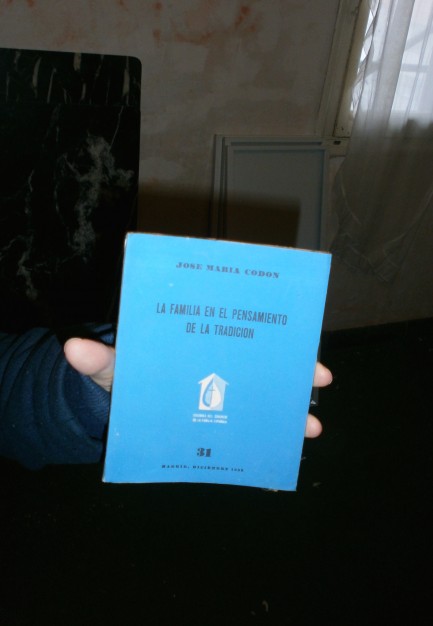
The last panel, below, shows the portrait of Francisco Franco just after we found it, and we suggest that if you have a portrait of any living politician in your home and you're not related to him or her, you're pretty far gone. The portrait is signed, but we can't identify the artist. IL something or LL something. Not Cool J, though considering Franco's regime abducted 300,000 children and sold thousands of them to couples as far away as South America, a lot of people would have fared better with a rapper in charge. Actually, it isn't fair to LL Cool J to set the bar that low. He'd do fine period. You also see in that shot PI-1's shapely stems. 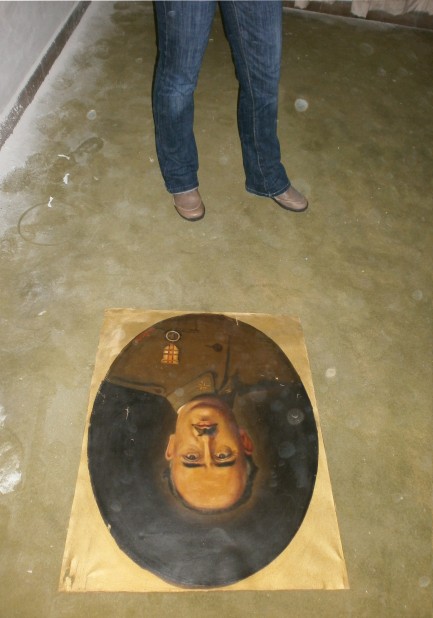 "Fascist" is the epithet du jour, but these artifacts were a reminder that important historical terms are cheapened by internet hoardes applying them to every school board head, municipal bureaucrat, and cable series showrunner with whom they disagree. Some leaders and personalities definitely deserve the label, obviously. As we mentioned above, our friend gave everything away, though we weren't clear whether it was wanted for academic or personal reasons. We thought perhaps a museum might be a good place for it all, but the items don't appear to have great value. For example, we found some Codón pamphlets on sale online for three euros. But even if they aren't worth much in cash, there was value for us in seeing them. We wouldn't have traded the morning for anything.
 Another valuable Spanish painting is ruined by someone who's all thumbs and no skills. 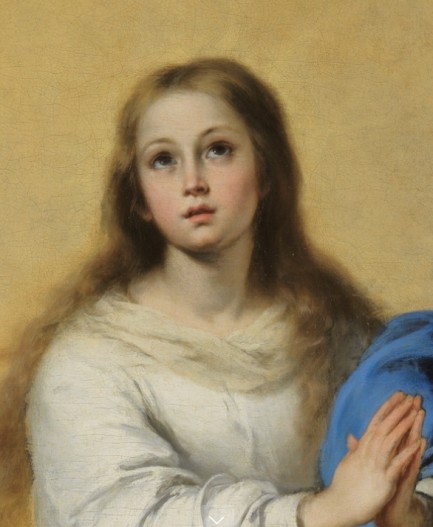
Spanish art restorers are in the news for the wrong reasons again. You may remember the infamous Ecce Homo disfigurement—the early 20th century fresco by Elías García Martínez that was ruined by amateur restorer Cecilia Giménez. The restoration, which took place in the town of Borja, was so botched that many Spaniards stopped referring to the painting as Ecce Homo—“Behold Man”—in favor of Ecce Mono—“Behold Monkey.” We've posted its Christ figure, angelic before, and afflicted after, below. We think the name change fits, though we think the after Christ also looks a bit like Leatherface.
The Ecce Homo fiasco soon grew to exemplify the divergent incentives of the modern world. The painting was destroyed. Its destruction turned the painting and the town of Borja into a tourist attraction. The restorer now claims she's proud of her work because of the money that tourists 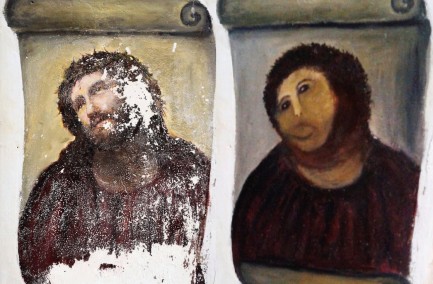 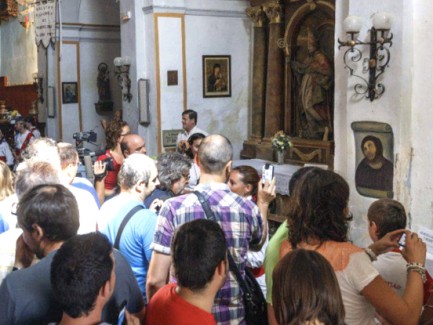 bring which can be used for good causes. The fact that these calamity tourists are posing with the painting only because it looks like Giménez restored it using a brush held between her ass cheeks is now immaterial. Only money matters. The money made has absolved her of responsibility for ruining the art. bring which can be used for good causes. The fact that these calamity tourists are posing with the painting only because it looks like Giménez restored it using a brush held between her ass cheeks is now immaterial. Only money matters. The money made has absolved her of responsibility for ruining the art.
The latest incident involves a more-than-century-old copy of Bartolomé Esteban Murillo's baroque painting La Inmaculada del Escorial, which you see at top. An art collector in Valencia hired a furniture restorer to clean the painting, but the face of the Virgin Mary was damaged. The collector then hired an art restorer to repair the damage, was forced to hire a second to fix the damage done by the first, and, well, see below. Now look up top again. Now look below. Yeah, that actually happened. We can't figure out how the second restorer made the painting look even less like the original than the first restorer. Did they not understand why they had been hired? These paintings aren't pulp art, but their destruction is like something from a comical crime novel. Not surprisingly, some Spaniards also consider these blunders criminal, and are now calling for regulation of the art restoration sector, and who can blame them?
Spanish art experts say botched restorations are more common than people know. We searched around and found a couple more, also hilariously awful (see the sculpture of St. George from the town of Estella, below). Generally, these incidents only become public when they're reported to the press or on social media, which isn't the norm, considering the embarrassment involved. But we can't help wondering if, going forward, ancient artworks will be deliberately ruined as a ploy to generate calamity tourism. We wouldn't put it past people. Maybe Behold Monkey should be renamed again, to Behold Money. Maybe Jesus has shown the way—to financial salvation. 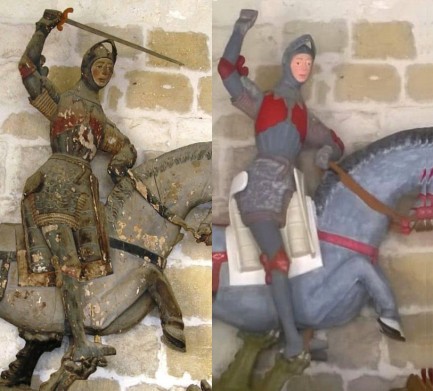 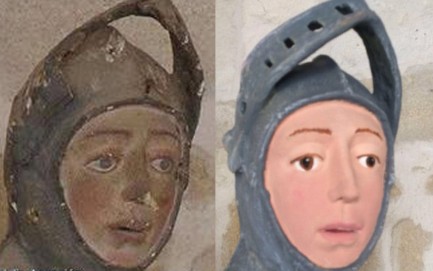
 For a little while at least, sports can bring a nation together. 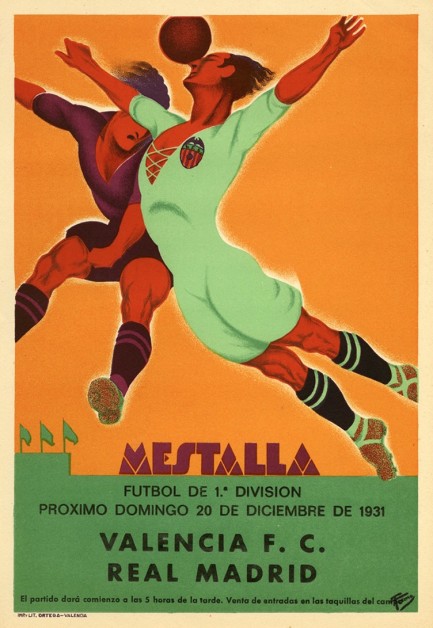
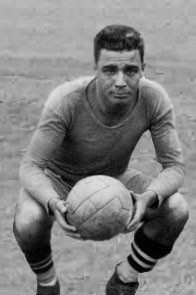 The art deco influenced fútbol poster above, which is signed in its lower right corner by an artist whose identity is unknown to us, advertises a match between top flight Spanish sides Valencia F.C. and Real Madrid at Valencia’s Estadio de Mestalla. Months earlier Spain had become a republic after years of dictatorship under Miguel Primo de Rivera, and was about to enter into a period of unrest and rising fascism, leading to civil war and decades more dictatorship under Francisco Franco. But on this particular winter Sunday in Valencia the sole battle took place on the pitch at Mestalla. The star player on the field was Manuel Olivares Lapeña, who you see at right, but it was Jaime Lazcano Escolá and Juan Costa Font who netted goals that day. The game ended in a 1-1 draw—a triumph for a Valencia squad languishing at the bottom third of the table. But Real Madrid won the league. The art deco influenced fútbol poster above, which is signed in its lower right corner by an artist whose identity is unknown to us, advertises a match between top flight Spanish sides Valencia F.C. and Real Madrid at Valencia’s Estadio de Mestalla. Months earlier Spain had become a republic after years of dictatorship under Miguel Primo de Rivera, and was about to enter into a period of unrest and rising fascism, leading to civil war and decades more dictatorship under Francisco Franco. But on this particular winter Sunday in Valencia the sole battle took place on the pitch at Mestalla. The star player on the field was Manuel Olivares Lapeña, who you see at right, but it was Jaime Lazcano Escolá and Juan Costa Font who netted goals that day. The game ended in a 1-1 draw—a triumph for a Valencia squad languishing at the bottom third of the table. But Real Madrid won the league.
 Spain is germane only if you look closely at Miss Crayne. 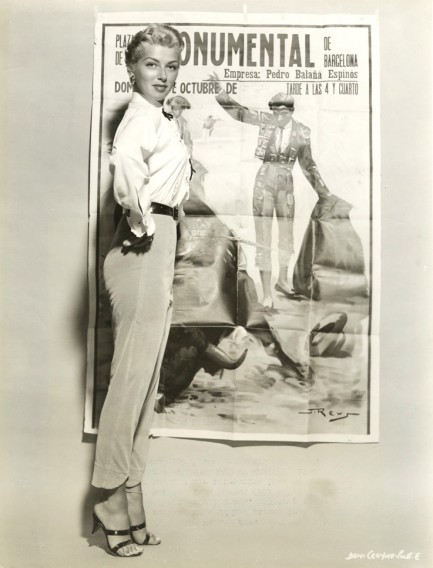 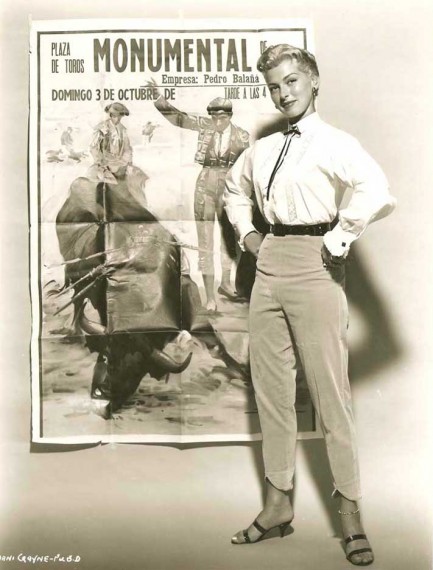
American actress Dani Crayne stands in front of a piece by the Valencian bullfight painter Juan Reus Parra, who signed his work J. Reus (not J. Revs, as many websites say) and was a top artist during the 1940s and 1950s. The poster advertises the Sunday bullfights at Barcelona’s impressive Moorish-Byzantine style La Monumental bullring. You would therefore think, this being a promo photo, that Crayne was shooting a movie having to do with bullfights or Spain, but she was actually filming Shoot-Out at Medicine Bend in the U.S., and it had zilch to do with bulls, Spain, or anything remotely Spanish. She is, though, wearing a somewhat Spanish outfit, and she looks great in it, so that must be the connection. The photo dates from 1957.
|
 |

The headlines that mattered yesteryear.
1933—The Gestapo Is Formed
The Geheime Staatspolizei, aka Gestapo, the official secret police force of Nazi Germany, is established. It begins under the administration of SS leader Heinrich Himmler in his position as Chief of German Police, but by 1939 is administered by the Reichssicherheitshauptamt, or Reich Main Security Office, and is a feared entity in every corner of Germany and beyond. 1937—Guernica Is Bombed
In Spain during the Spanish Civil War, the Basque town of Guernica is bombed by the German Luftwaffe, resulting in widespread destruction and casualties. The Basque government reports 1,654 people killed, while later research suggests far fewer deaths, but regardless, Guernica is viewed as an example of terror bombing and other countries learn that Nazi Germany is committed to that tactic. The bombing also becomes inspiration for Pablo Picasso, resulting in a protest painting that is not only his most famous work, but one the most important pieces of art ever produced. 1939—Batman Debuts
In Detective Comics #27, DC Comics publishes its second major superhero, Batman, who becomes one of the most popular comic book characters of all time, and then a popular camp television series starring Adam West, and lastly a multi-million dollar movie franchise starring Michael Keaton, then George Clooney, and finally Christian Bale. 1953—Crick and Watson Publish DNA Results
British scientists James D Watson and Francis Crick publish an article detailing their discovery of the existence and structure of deoxyribonucleic acid, or DNA, in Nature magazine. Their findings answer one of the oldest and most fundamental questions of biology, that of how living things reproduce themselves. 1967—First Space Program Casualty Occurs
Soviet cosmonaut Vladimir Komarov dies in Soyuz 1 when, during re-entry into Earth's atmosphere after more than ten successful orbits, the capsule's main parachute fails to deploy properly, and the backup chute becomes entangled in the first. The capsule's descent is slowed, but it still hits the ground at about 90 mph, at which point it bursts into flames. Komarov is the first human to die during a space mission.
|

|
|

It's easy. We have an uploader that makes it a snap. Use it to submit your art, text, header, and subhead. Your post can be funny, serious, or anything in between, as long as it's vintage pulp. You'll get a byline and experience the fleeting pride of free authorship. We'll edit your post for typos, but the rest is up to you. Click here to give us your best shot.

|
|










 by the nationalist rebels during the Civil War. With the help of Hitler and Mussolini they prevailed in the conflict, after which the Falange became Spain's only legal political party, with the yoke and arrows one of its main symbols. This example is made of brass. Below that is a fascist flag, and you see the yoke and arrows on it, separated left and right on the bottom. This particular flag is not a perfect match with any we saw online, but it resembles the Spanish Army flag used between 1940 and 1945.
by the nationalist rebels during the Civil War. With the help of Hitler and Mussolini they prevailed in the conflict, after which the Falange became Spain's only legal political party, with the yoke and arrows one of its main symbols. This example is made of brass. Below that is a fascist flag, and you see the yoke and arrows on it, separated left and right on the bottom. This particular flag is not a perfect match with any we saw online, but it resembles the Spanish Army flag used between 1940 and 1945.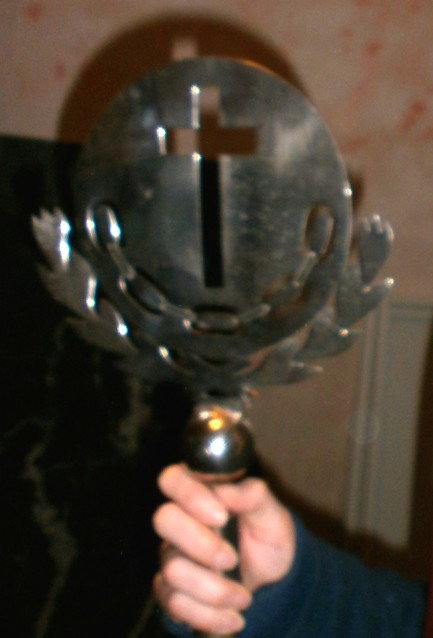
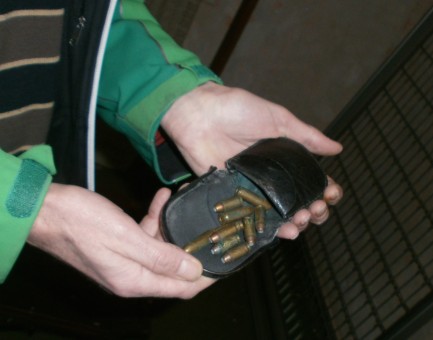
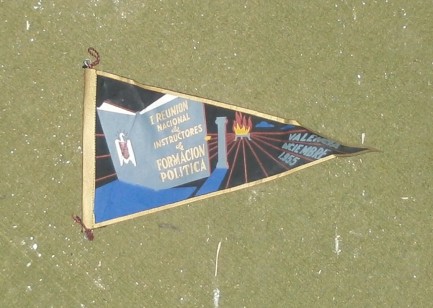





 bring which can be used for good causes. The fact that these calamity tourists are posing with the painting only because it looks like Giménez restored it using a brush held between her ass cheeks is now immaterial. Only money matters. The money made has absolved her of responsibility for ruining the art.
bring which can be used for good causes. The fact that these calamity tourists are posing with the painting only because it looks like Giménez restored it using a brush held between her ass cheeks is now immaterial. Only money matters. The money made has absolved her of responsibility for ruining the art.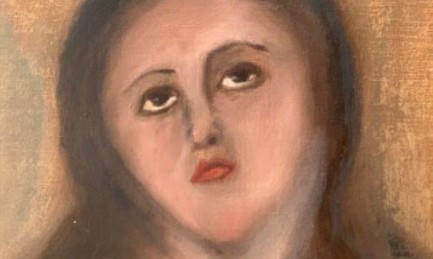
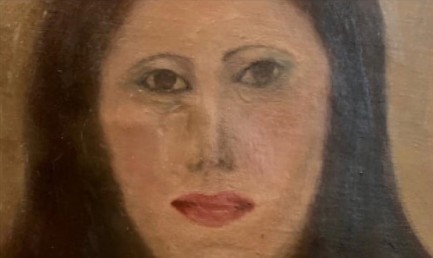




 The art deco influenced fútbol poster above, which is signed in its lower right corner by an artist whose identity is unknown to us, advertises a match between top flight Spanish sides Valencia F.C. and Real Madrid at Valencia’s Estadio de Mestalla. Months earlier Spain had become a republic after years of dictatorship under Miguel Primo de Rivera, and was about to enter into a period of unrest and rising fascism, leading to civil war and decades more dictatorship under Francisco Franco. But on this particular winter Sunday in Valencia the sole battle took place on the pitch at Mestalla. The star player on the field was Manuel Olivares Lapeña, who you see at right, but it was Jaime Lazcano Escolá and Juan Costa Font who netted goals that day. The game ended in a 1-1 draw—a triumph for a Valencia squad languishing at the bottom third of the table. But Real Madrid won the league.
The art deco influenced fútbol poster above, which is signed in its lower right corner by an artist whose identity is unknown to us, advertises a match between top flight Spanish sides Valencia F.C. and Real Madrid at Valencia’s Estadio de Mestalla. Months earlier Spain had become a republic after years of dictatorship under Miguel Primo de Rivera, and was about to enter into a period of unrest and rising fascism, leading to civil war and decades more dictatorship under Francisco Franco. But on this particular winter Sunday in Valencia the sole battle took place on the pitch at Mestalla. The star player on the field was Manuel Olivares Lapeña, who you see at right, but it was Jaime Lazcano Escolá and Juan Costa Font who netted goals that day. The game ended in a 1-1 draw—a triumph for a Valencia squad languishing at the bottom third of the table. But Real Madrid won the league. 
